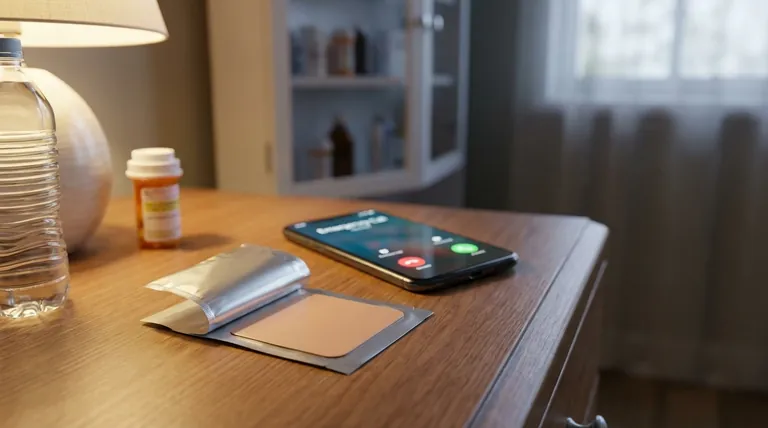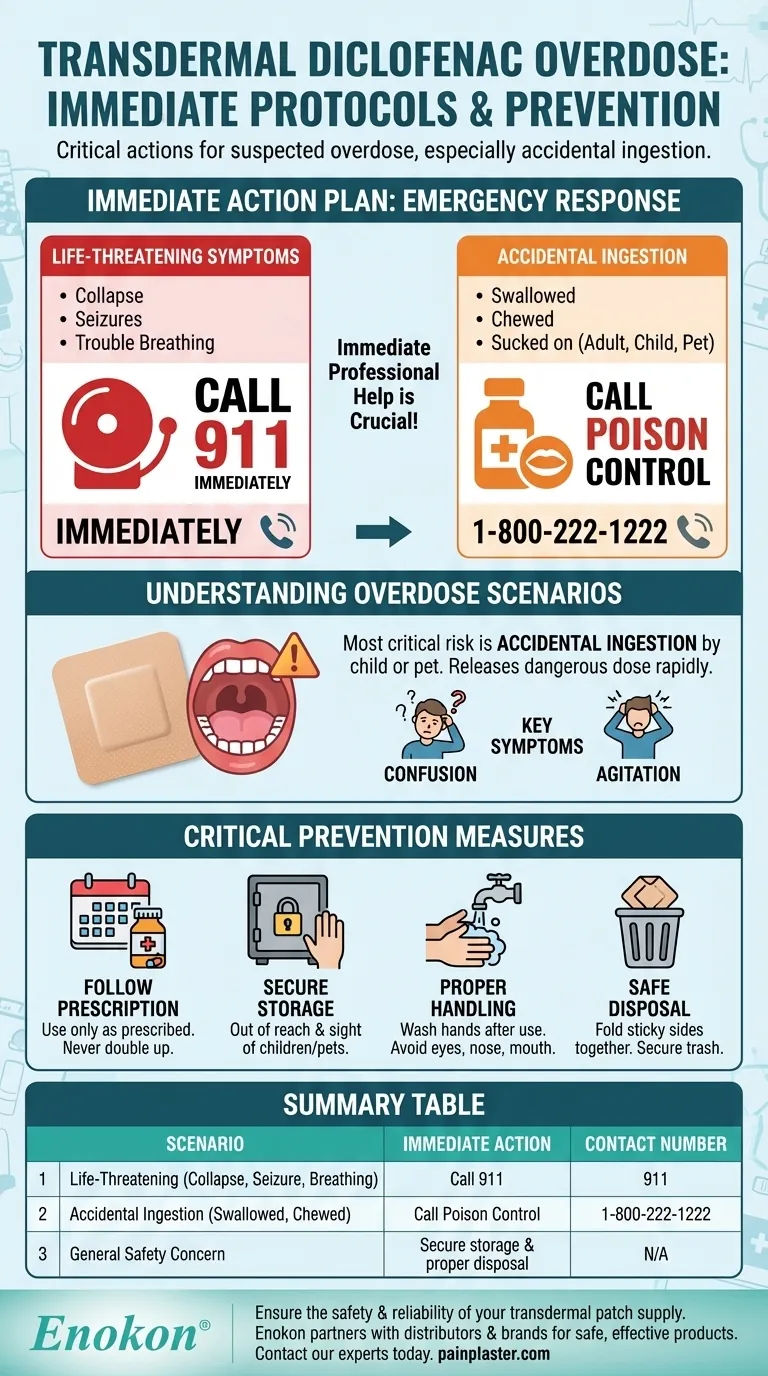In the case of a suspected overdose with transdermal diclofenac, you must seek immediate medical help. The correct action depends on the victim's condition: call 911 if they have collapsed or are having trouble breathing, and contact a Poison Control center for any instance of swallowing or chewing a patch.
A diclofenac patch overdose, especially from accidental ingestion by a child or pet, is a medical emergency. Your immediate response should be to call for professional medical help, followed by implementing strict safety protocols to prevent future incidents.

Understanding Overdose Scenarios
The most significant risk of a severe overdose from a diclofenac patch comes not from wearing it for too long, but from accidental ingestion.
Accidental Ingestion (Swallowing or Chewing)
This is the most critical overdose scenario. If an adult, child, or pet swallows, chews, or sucks on a diclofenac patch, it can release a large, dangerous dose of the medication into their system.
This type of exposure requires immediate professional intervention.
Symptoms of a Potential Overdose
While the patch delivers medication slowly through the skin, ingestion or significant misuse can lead to systemic effects. Be alert for symptoms like confusion and agitation.
The Immediate Action Plan
Your response should be swift and decisive. Follow this two-tiered protocol based on the severity of the situation.
When to Call 911 Immediately
Call emergency services at 911 without delay if the person who has been overexposed:
- Has collapsed or cannot be awakened
- Is having a seizure
- Is having trouble breathing
These are signs of a life-threatening emergency.
When to Contact Poison Control
For any case where a patch has been swallowed, chewed, or sucked on, you must call for help.
Contact the national Poison Control helpline at 1-800-222-1222. Their experts can provide immediate instructions for your specific situation.
Critical Safety and Prevention Measures
Preventing an overdose is the most important step. Diclofenac patches must be handled with the same care as any potent medication.
Follow Prescription Instructions
Use the patch only as prescribed by your doctor. Never apply an extra patch to make up for a missed dose. If you forget, apply a new one as soon as you remember, but skip the missed dose if it's almost time for your next one.
Secure Storage is Non-Negotiable
Always store new and used patches out of reach and sight of children and pets. Accidental ingestion is the leading cause of severe overdose incidents.
Proper Handling and Application
Always wash your hands with soap and water after handling a patch. Avoid touching your eyes, nose, or mouth during application or removal.
Safe Disposal of Used Patches
A used patch still contains a significant amount of medication. To dispose of it safely, fold the patch in half with the sticky sides together before placing it in the trash. This prevents accidental exposure to others.
How to Apply This to Your Situation
Your response depends entirely on whether you are facing an active emergency or seeking to establish safe practices.
- If you are facing an active emergency: Immediately call 911 for severe symptoms like collapse or breathing difficulty, or call Poison Control at 1-800-222-1222 for any instance of ingestion.
- If you are concerned about general safety: Implement strict storage and disposal protocols immediately, keeping patches away from children and pets at all times.
- If you missed a dose: Do not double up. Apply your next dose as scheduled or as soon as you remember, but never wear two patches at once to "catch up."
Ultimately, treating this medication with respect and ensuring it is always handled and stored securely is the key to using it safely.
Summary Table:
| Scenario | Immediate Action | Contact Number |
|---|---|---|
| Life-Threatening Symptoms (Collapse, seizure, trouble breathing) | Call 911 immediately. | 911 |
| Accidental Ingestion (Swallowed, chewed, or sucked on by a person or pet) | Call Poison Control for instructions. | 1-800-222-1222 |
| General Safety Concern (Preventing future incidents) | Secure storage and proper disposal. | N/A |
Ensure the safety and reliability of your transdermal patch supply. As a bulk manufacturer of reliable transdermal patches and pain plasters, Enokon partners with healthcare and pharmaceutical distributors and brands. Benefit from our technical expertise for custom R&D and development to deliver safe, effective products to your customers. Contact our experts today to discuss your manufacturing needs.
Visual Guide

Related Products
- Asthma Cough and Pain Relief Patch for Adults and Kids
- Far Infrared Deep Heat Relief Patches Medicated Pain Relief Patches
- Mugwort Wormwood Pain Relief Patch for Neck Pain
- Menthol Gel Pain Relief Patch
- Icy Hot Menthol Medicine Pain Relief Patch
People Also Ask
- Are pain relief patches safe for sensitive skin? Your Guide to Safe Use & Skin Testing
- What types of coughs can the far infrared cough relief patch address? Soothe Dry, Wet, and Persistent Coughs
- What are the key benefits of using the cough relief patch? Soothe Your Cough with Targeted, Non-Oral Relief
- What role do natural ingredients and acupoint stimulation play in a cough relief patch? Synergistic Relief Explained
- How should missed doses of the Reliever Patch be handled? Safe Usage Guidelines















